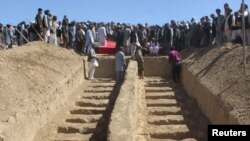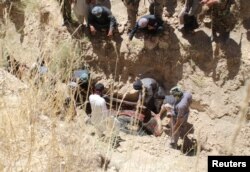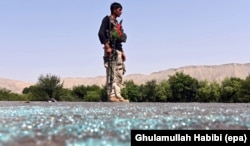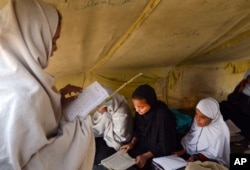Recent terror attacks claimed by the Islamic State militant group in Afghanistan indicate an increase in the atrocities it's committing against civilians and a deliberate attempt to wreak havoc and spread fear among noncombatants in the country.
Since its emergence in 2015, the extremist group has claimed responsibility for a number of deadly attacks across Afghanistan and has been accused of indiscriminately attacking civilians in general and the Shi'ite minority in particular.
On Monday, the terror group claimed responsibility for a deadly attack that occurred last week in Afghanistan's northern Sar-e-Pul province, killing about 54 Shi'ite Muslims, including children and elderly, in the Mirza Olang region.
Afghan officials said Wednesday that local police had discovered several mass graves in Sar-e-Pul province, containing the bodies of the Mirza Olang massacre.
In early August, the group attacked a Shi'ite mosque in western Herat province, killing and injuring dozens of worshippers.
In July 2016, IS claimed responsibility for attacking a rally of peaceful protesters in Kabul, killing more than 80 and injuring dozens more.
IS weakening?
Michael Kugelman of the Wilson Center, a nonpartisan policy forum in Washington, said the increase in IS attacks in Afghanistan and the terror group's targeting of civilians illustrate weakness rather than strength.
"[IS] is intent to show that it's still relevant and dangerous in Afghanistan, even as its fighters are targeted by airstrikes, and even as its brutalities discredit it in the eyes of Afghans," Kugleman said. "On the contrary, we should read it as an effort on the part of an insecure IS to show that it still has clout."
Farooq Bashar, an Afghan analyst in Kabul, agreed with Kugleman's analysis and added that part of the increase in IS attacks is related to continuing White House deliberations about what course of action the U.S. will take in Afghanistan.
Bashar said he thought IS wanted to pose itself as a relevant group with which to to be reckoned.
"Islamic State is a new phenomenon in Afghanistan and by targeting Afghan civilians, it wants to demonstrate to the U.S. and the world that it has a strong presence in Afghanistan and the region," Bashar said.
Increasing pressure
Initially based in southern parts of eastern Nangarhar province, IS's Khorasan branch, also known as ISIS-K, emerged in early 2015 in the mountainous areas of Afghanistan and Pakistan to cover those nations and "other nearby territories." The group is trying to expand to mountainous parts of the adjacent Kunar and Nuristan provinces, which share a border with Pakistan.
In addition, the terror group recently has made inroads in the country's northern Jawzjan and Sar-e-Pul provinces.
Most of the IS fighters are former members of the Pakistani Taliban group (TTP), many of whom belong to the Orokzai tribe in Pakistan, according to U.S. and Afghan officials.
A number of Central Asian militants in Afghanistan, who previously were associated with al-Qaida and Taliban, have joined the IS cause. Some Afghan militants also have joined the terror group for financial incentives.
In recent months, U.S. and Afghan forces have been engaged in joint counterterrorism operations against IS in eastern Afghanistan, killing hundreds of its fighters, including several of its senior commanders.
American and Afghan military forces have promised to eliminate IS in Afghanistan in 2017.
Atrocities in Nangarhar
Initially emerging in the Achin district of eastern Nangarhar province, IS has attacked villages in several other districts there, targeting local residents and elders deemed repugnant to its extremist ideology, local Afghan officials told VOA.
An IS video in 2015 showed horrific killing of a dozen local men from the Shinwari tribe in Nangarhar, who were blindfolded by IS fighters before being blown up by bombs buried underneath them.
Last summer, IS militants launched a massive assault on various parts of Kot district in Nangarhar province, which resulted in the deaths of dozens of villagers.
Niaz Bibi, a mother of 12 in the remote village of Qalajaat, watched as IS fighters invaded her home and killed five of her nine sons because they were affiliated with the local police force.
"They first shot my sons and then beheaded them in front of me," Bibi told VOA in a telephone interview at the time.
In October 2016, the group overran several checkpoints operated by militias in Nangarhar's Pachiragam district, killing dozens of local militia members and civilians in the region, local tribesmen and authorities told VOA.
The terror group on many occasions also has abducted local villagers.
A group of women who were captured by IS fighters in Nangarhar in early 2016 — they were held captive for more than four months before they were released as part of a prisoner-swap deal negotiated by tribal elders in the region — told VOA that IS starved them in dark cells.
"They kept beating us and telling us that they would kill us because we had become Kaafir [non-Muslim]," one of the women told VOA.
Keeping schools shuttered
The group also has forbidden state-run and private schools from operating in areas under its control, depriving tens of thousands of students from school.
The terror group reportedly has warned girls in northern Jawzjan province, who make up 40 percent of the 18,000 enrolled students, not to attend schools. It requires schools in areas under its control to adopt IS curriculum, and it forces parents to send their children to a growing network of religious seminaries run by IS.
"IS fighters use local madrassas [seminaries] as military centers where they teach militancy, conduct military training and plan their activities," Abdul Zahir Haqqani, director of religious affairs in Nangarhar, told VOA in November 2016.












